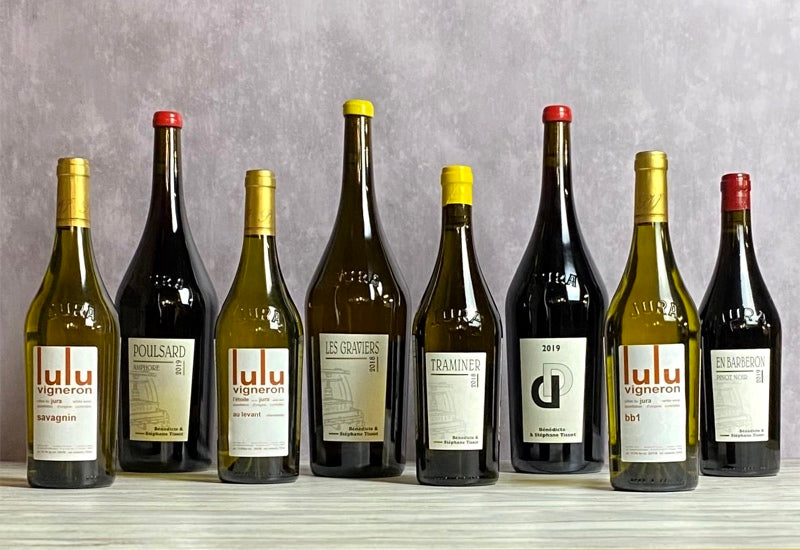Jura is much closer to Burgundy than you may think. And yet so far away in almost every non-geographical aspect. It's just 80 odd km south east from Meursault to L'Etoile but their Chardonnays sure don't taste the same.
Burgundy is classic; Chardonnay and Pinot Noir, rich owners, prestigious domaines, the head of the dinner table. Jura is the unconventional; the idiosyncratic uncle at the French Wine Regions' Annual Christmas Lunch.
It's not mountainous, more hilly and picturesque - the vineyards are just in the foothills of the Jura mountains themselves. Quaint villages, cows and sheep dot the rolling slopes. Comte cheese of course. Switzerland is not far away.
The bucolic, natural feel is mirrored in natural winemaking ethos of the region, where ancient winemaking techniques have been passed on, essentially untouched, for generations. The wines of this region hark back to a time before modern technology. The cellars and the families that pick and ferment the grapes are as intrinsic to the wines as the vineyards themselves.
The region runs sort of north to south, with more vineyards in the north, around the village of Arbois, Pupillin and Montigny-Les-Arsures. Moving south is the spectacular hill top 'village' of Chateau-Chalon, then you reach the Chardonnay heartland of L'Etoile. It's not a large region, around 70 kms north to south, and with only around 2,000 hectares of vines, many of which are tucked away in hidden pockets, rather than ostentatiously spread over land as far as the eye can see. It's only about .2% of France's annual wine production.
There are eight Jura appellations, reflecting both geography and wine style: Arbois, Château-Chalon, L’Etoile and Côtes du Jura are the geographic appellations. Crémant du Jura, Macvin du Jura, and Marc du Jura are the wine styles. The region's sparkling wines, the Cremants, are extremely important, representing over a quarter of annual production. They are also delicious.

Chardonnay is the dominant white grape with almost half of the region's plantings. It can be electric, making taut, high energy wines, sometimes fresh and floral, often rich, nutty and oxidative. But Savagnin is Jura's calling card, a somewhat neutral grape (also known as Traminer, a cousin of Gewurztraminer) that can reach great heights in the limestone/ clay hills of southern Jura in particular. And with the region's oxidative winemaking tendencies they can be most distinctive, a very acquired taste. Its peak can be seen in the region's famous Vin Jaunes - dark yellow-coloured wines that have been aged in barrel for over six years, under a veil of yeast flor, the kind you see in fino sherry. These are the 'sous-voile' wines, the traditional winemaking of the region.
And the peakiest peak would be the wines from Chateau-Chalon - which is an appellation not a winery name. Only Vin Jaunes qualify for this label, bottled in traditional 620ml bottles called 'clavelins' - such is the evaporative effect of the barrel aging that this is all the liquid remaining from an original litre, according to local lore. They are intense and powerful table wines, capable of long aging, and often need a lot of time between opening and drinking.
There has been a recent shift in Jura whites, away from the uber-oxidative styles towards a more modern style that is not so divisive. We are seeing more 'ouille' wines, that is Savagnins and Chardonnays made in the normal fashion of keeping the barrels topped up to avoid oxidation, evaporation and the flor development. There also seems to be less oxidation in the standard Savagnins and Chardonnays. The backbone of crunchy acidity, incredible floral aromatics and powerfully bright fruit still shine through.
Jura reds are a delight, very much in the zeitgeist of lighter, delicate styles, with lowish alcohols, tangy acidity and early drinkability. Trousseau, Pinot Noir and Poulsard are the main varieties, with Trousseau making the more powerful ageworthy styles. The Pinots are more skeletal and edgy than in Burgundy but can be terrific value in comparison. Poulsard makes a very pale red, veering on rose. It's known in some villages, such as Pupillin, as Ploussard because well...France. The reds are often blended.

Jura has had a difficult time of late. Weather issues dominate local discussions. Warm winters have meant early budburst, and exposure to deadly late frosts. Increased storm activity has added hail damage to the list of problems. Increasing hype and global demand has pushed prices higher as there is less wine available.
So if you can find some Jura wines, give them a go, as they may not be around for long. Names such as Ganevat, Overnoy, Puffeney and Tissot have become as sought-after as many of France's greatest wines.
SHOP JURA
[product align="left" limit="8" cols="4" handle_collection="jura" hover="base" hide_pagination="true" hide_buttons="false" use_countdown="false" loop_countdown="false" collection_countdown_style="dark" ]


